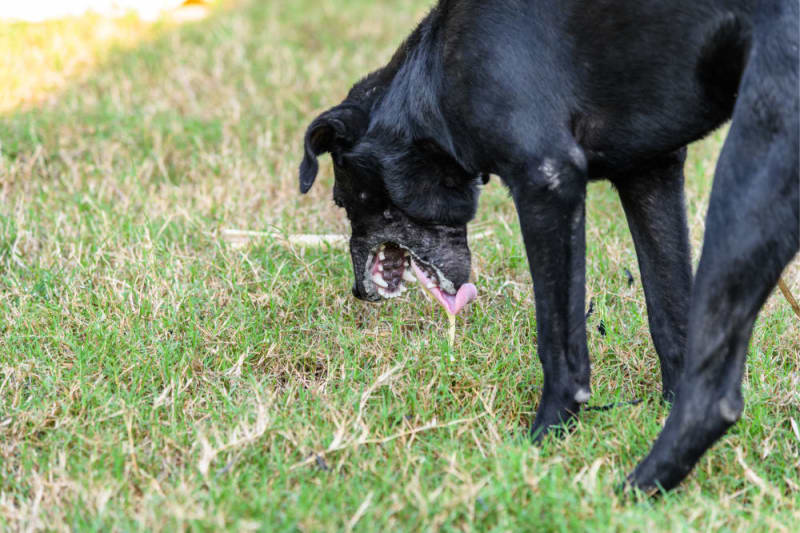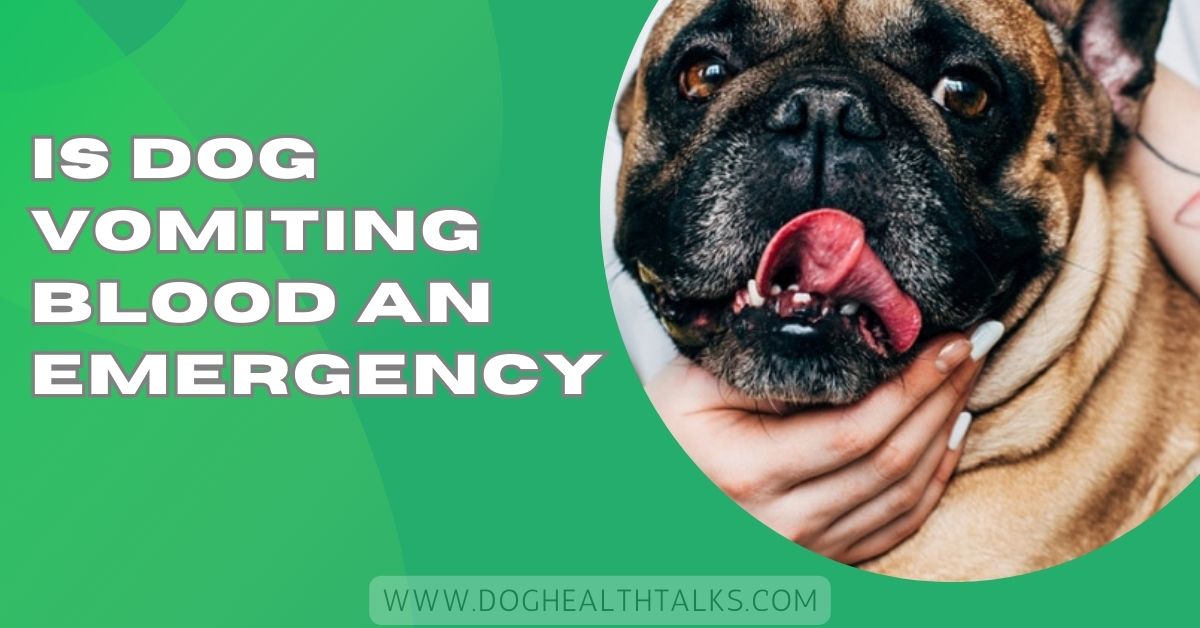Seeing blood in your dog’s vomit can be one of the scariest moments for any pet parent. While it doesn’t always mean the worst, it is never something to ignore.
Blood in your dog’s vomit is always an emergency. It can signal serious health issues, so don’t wait. Contact a veterinarian immediately to ensure your pet’s safety and receive proper treatment.
Understanding what it means, what causes it, and when to seek help could save your dog’s life. This guide provides a clear and concise explanation of everything you need to know, presented in simple, step-by-step instructions.
When a dog vomits blood, it means there is bleeding somewhere inside the body—often in the stomach, intestines, or throat.
The blood may look bright red, dark, or like coffee grounds. Even a small amount signals irritation, injury, or infection.
Sometimes it’s linked to ulcers, swallowing sharp objects, or illness. Because it’s never normal, vomiting blood should always be taken seriously. Quick attention from a vet can help find the cause and keep your dog safe.

- Stomach or intestinal ulcers – these painful sores can form due to stress, certain medications, or an underlying illness, leading to bleeding in the digestive tract.
- Foreign objects – dogs may swallow bones, toys, or sharp items that scratch or tear the stomach or intestines, causing visible blood in vomit.
- Infections – serious illnesses, such as parvovirus, parasites, or bacterial infections, can damage the gut lining and trigger bloody vomiting.
- Liver or kidney disease – these conditions may interfere with normal blood clotting, which can result in bleeding inside the stomach.
- Toxins or poisons – harmful foods, toxic plants, or household chemicals can irritate or injure the digestive system, leading to bleeding.
- Medications – some drugs, especially pain relievers or steroids, may irritate the stomach lining and cause ulcers or bleeding.
- Tumors or cancer – growths inside the digestive tract can bleed when irritated or damaged, sometimes showing up as blood in vomit.
Yes—always. Vomiting blood is a red flag that something inside your dog isn’t right. Even if it’s only a small spot or your dog seems normal otherwise, hidden problems like ulcers, infections, or internal bleeding can worsen rapidly.
Waiting may allow a treatable issue to become a serious problem. A veterinarian can examine your dog, run necessary tests, and provide safe treatment. Visiting or calling your veterinarian promptly is the safest choice for your pet’s health.
Treatment depends on the cause of the vomiting. First, a vet examines your dog, reviews history, and may run blood work, X-rays, or scans.
Once the cause is identified, treatment may include medication for nausea, stomach protectants, IV fluids, antibiotics, or even surgery if a foreign object is lodged.
If an illness, such as liver or kidney disease, is the underlying cause, your vet will treat that as well. The primary goal is to prevent vomiting and keep your dog safe.
You can’t prevent every case, but you can lower the risk. Feed your dog a balanced diet and stick to a routine feeding schedule.
Keep toxic foods, sharp bones, and harmful chemicals far out of reach. Never give human medicine unless a vet prescribes it, as some drugs cause dangerous stomach ulcers.
Stay consistent with vet check-ups, vaccines, and parasite prevention. Identifying minor issues early and maintaining a safe environment are the most effective ways to protect your dog.

Dogs may vomit blood when something irritates, injures, or bleeds inside their digestive tract. Common causes include ulcers, swallowed objects, infections, toxins, or diseases affecting the liver, kidneys, or blood clotting.
Even stress or certain medications can play a role. The key thing to remember is that blood is never normal in vomit.
It’s a warning sign that your dog’s body needs help, and quick veterinary care is the safest step forward.
Mild cases may look like a small streak or a few drops of fresh red blood mixed with vomit. Your dog might seem otherwise normal—still eating, drinking, and playing.
While this can be less urgent than heavy bleeding, it’s still not safe to ignore. Even minor irritation or injury can worsen quickly.
If you see blood, call your vet for advice. A professional check-up ensures minor problems don’t grow into something more serious.
Severe cases often involve vomit that looks dark, grainy, or like coffee grounds—signs of digested blood.
You may also notice your dog vomiting repeatedly, becoming weak, showing pale gums, or acting unusually tired. In severe cases, dogs may collapse or appear to be in pain.
These symptoms point to significant internal bleeding or dangerous illness. If you see them, treat it as an emergency. Take your dog to a veterinary clinic immediately to ensure their safety.
Contact your veterinarian or the nearest emergency clinic immediately. Describe the color, amount, and frequency of vomit, plus any other symptoms. The vet can guide your next steps and advise you on whether immediate care is necessary.
Keep a close eye on your dog while preparing to leave. Look for repeated vomiting, pale gums, weakness, or sudden tiredness.
If these signs appear, treat it as a medical emergency. The faster you respond, the safer your pet will be.
Transport your dog calmly to reduce stress. Use a secure carrier or harness, bring towels in case of more vomiting, and, if possible, collect a sample for the vet. A safe and quick trip ensures better care upon arrival.
Bloody vomit in dogs can sometimes point to serious, even life-threatening problems. Conditions like parvovirus, stomach ulcers, internal bleeding, poisoning, or cancer can quickly worsen if left untreated.
These issues often cause more than one symptom, such as weakness, pale gums, or constant vomiting.
Acting fast is extremely important—waiting too long may risk your dog’s life. If you notice blood along with severe signs, don’t delay.
Contact your veterinarian or an emergency clinic immediately to ensure your pet’s safety and well-being.
Dehydration can make vomiting worse, but too much water may upset your dog’s stomach further. Offer small, frequent sips instead of a full bowl.
This helps keep them hydrated safely without straining their digestive system while you prepare for the vet visit.
Always consult your veterinarian’s advice before trying home remedies. They may instruct you to withhold food, monitor symptoms, or come in immediately.
Following professional guidance ensures your dog receives safe and effective care, preventing mistakes that could worsen their condition.
Dogs thrive on routine. Feeding your pet at the exact times each day helps their digestion and prevents stomach upset.
Avoid giving scraps or sudden diet changes, since these can irritate their stomach and sometimes lead to vomiting or more serious health issues.
If your dog has ongoing health issues, such as liver disease, ulcers, or allergies, follow the treatment plan provided by your veterinarian.
Regular monitoring and medication can prevent flare-ups. Tackling these root causes is one of the best ways to reduce the risk of future bloody vomiting episodes.

Yes, it can be. Even a small amount of blood in vomit should be taken seriously. While you keep your dog calm and away from food, call your veterinarian right away to ensure safe and professional guidance.
Some dogs may seem fine after vomiting blood, but that doesn’t mean they’re safe. Internal issues can develop quietly. Always treat it as urgent and have your vet check them, even if your dog appears active or playful.
There are no safe home remedies for bloody vomit. Offering water in small sips is acceptable, but avoid giving food or treatments without a veterinarian’s advice. Immediate veterinary care is the safest and most practical step to protect your dog.
In some cases, bloody vomit can be a final sign of severe illness, such as organ failure or internal bleeding. If your dog shows this along with weakness or collapse, seek emergency help immediately to prevent unnecessary suffering.
Bloody vomit is always an emergency, and home remedies aren’t safe. Avoid giving food or human medicine. Instead, keep your dog calm, offer tiny sips of water if needed, and contact a vet or emergency clinic immediately.
Yes. If your dog vomits blood after eating, it may be a sign of ulcers, poisoning, or an object stuck in the stomach.
Don’t wait to see if it improves—call your vet quickly. Early action can make treatment safer and more effective.
When blood appears with mucus, it may point to stomach irritation, infection, or ulcers. This is not normal and should never be ignored. Contact your veterinarian as soon as possible so they can identify and address the underlying cause.
First aid means keeping your dog safe until you reach the vet. Please don’t feed them, avoid medicines, and offer only small sips of water.
Keep them calm, prepare transportation, and seek veterinary help immediately—it’s the only reliable solution.
Yes. Even a slight trace of blood can indicate a serious condition. Always call your vet quickly—it’s the safest way to protect your dog’s health.
Acting normal doesn’t mean safe. Internal problems may still exist. Don’t wait—contact your vet immediately to rule out ulcers, poisoning, or hidden internal bleeding.
Don’t wait. If your dog vomits blood, treat it as an emergency. Call the nearest emergency clinic right away—quick action can save their life.
Keep your dog calm and comfortable. Lay a towel in the car, avoid food, offer only tiny sips of water, and head straight to the vet.
5. How do you know if blood is serious in vomit?
Any blood in vomit is serious. A bright red or dark coffee-ground color indicates bleeding. Always seek veterinary help—don’t try to judge it at home.
Seeing blood in your dog’s vomit is frightening, but what matters most is how quickly you respond. Even if your dog looks fine, bloody vomit is never normal and should always be treated as an emergency. Acting fast by calling your vet or heading to an emergency clinic can make all the difference in your dog’s recovery. With the proper care, many causes of bloody vomit can be treated successfully. As a pet parent, staying alert and seeking help right away is the best way to keep your dog safe and healthy.
